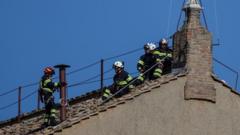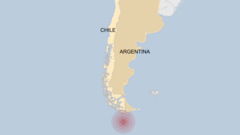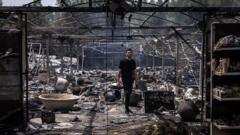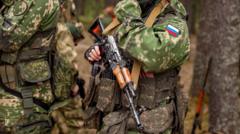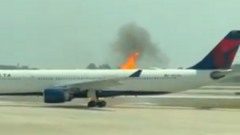Over 130,000 individuals evacuated, with significant impacts on local communities and high-profile celebrities.
Hollywood Hills Faces Evacuation Amidst Widespread LA Wildfires
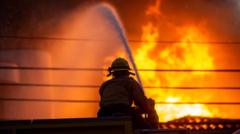
Hollywood Hills Faces Evacuation Amidst Widespread LA Wildfires
Residents flee as fiery infernos sweep through Los Angeles neighborhoods, claiming lives and properties.
As wildfires continue to rage across Los Angeles, a mandatory evacuation order has been enacted in the Hollywood Hills due to escalating threats to public safety. The Los Angeles Fire Department (LAFD) has cautioned residents about the "immediate threat to life" posed by multiple active fires in the area. Tragically, five lives have been lost as evacuations have surged past 130,000 individuals. The flames have devastated numerous homes, impacting both regular residents and high-profile celebrities such as Paris Hilton and Billy Crystal.
The initial fire sparked in the Pacific Palisades area on Tuesday, rapidly leading to additional outbreaks in various north Los Angeles neighborhoods. As of the latest update at 20:15 local time, considerable portions of the Palisades, Pasadena, Sylmar, and Hollywood Hills had already caught fire, totaling more than 27,000 acres (about 42 square miles) ravaged without containment.
The fire ignited in the Hollywood Hills, a residential neighborhood known for its picturesque views of the city, around 18:00 local time on Wednesday. Less than two hours later, dense smoke enveloped the Hollywood area, obscuring visibility and creating hazardous conditions for residents trying to evacuate. Many were observed struggling to breathe, using makeshift masks and hurriedly packing essential items. Reports indicate that congested roads, including the iconic Hollywood Boulevard, resulted in gridlocked traffic as people abandoned vehicles or maneuvered dangerously in their efforts to escape.
Residents such as Anna Waldman reacted abruptly as chaos unfolded. Compelled to return home after initially stepping outside, she witnessed the imminent threat and quickly gathered her belongings, including necessities for her three dogs. "I can't believe this," she expressed, an overwhelming sense of disbelief hanging over her.
Compounding the difficulties, emergency responders have experienced a critical shortage of water, forcing crews to draw from local pools and ponds to combat the flames. Despite having three million-gallon water tanks filled prior to the incidents, the challenging nature of the wildfires has overwhelmed local capabilities designed for urban firefighting efforts, creating significant concerns about future incidents. As the fires continue to develop, the emotional and material toll on affected communities remains profound.
The initial fire sparked in the Pacific Palisades area on Tuesday, rapidly leading to additional outbreaks in various north Los Angeles neighborhoods. As of the latest update at 20:15 local time, considerable portions of the Palisades, Pasadena, Sylmar, and Hollywood Hills had already caught fire, totaling more than 27,000 acres (about 42 square miles) ravaged without containment.
The fire ignited in the Hollywood Hills, a residential neighborhood known for its picturesque views of the city, around 18:00 local time on Wednesday. Less than two hours later, dense smoke enveloped the Hollywood area, obscuring visibility and creating hazardous conditions for residents trying to evacuate. Many were observed struggling to breathe, using makeshift masks and hurriedly packing essential items. Reports indicate that congested roads, including the iconic Hollywood Boulevard, resulted in gridlocked traffic as people abandoned vehicles or maneuvered dangerously in their efforts to escape.
Residents such as Anna Waldman reacted abruptly as chaos unfolded. Compelled to return home after initially stepping outside, she witnessed the imminent threat and quickly gathered her belongings, including necessities for her three dogs. "I can't believe this," she expressed, an overwhelming sense of disbelief hanging over her.
Compounding the difficulties, emergency responders have experienced a critical shortage of water, forcing crews to draw from local pools and ponds to combat the flames. Despite having three million-gallon water tanks filled prior to the incidents, the challenging nature of the wildfires has overwhelmed local capabilities designed for urban firefighting efforts, creating significant concerns about future incidents. As the fires continue to develop, the emotional and material toll on affected communities remains profound.



